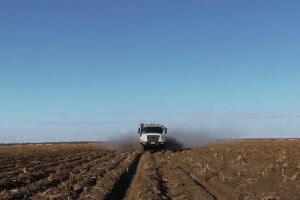The benefits of returning cotton textile waste to fields

An Australian trial on a cotton farm has shown it was safe to put large amounts of cotton textile waste into the soil, with no harm done to soil health or cotton yields. It could offer benefits to soil health.
Dr Oliver Knox, a cotton industry supported soil scientist, says that at the very least, the trial showed that no harm was done to soil health, with microbial activity slightly increased and at least 2,070kg of Carbon Dioxide equivalents (CO2 e) mitigated through the breakdown of these garments in soil rather than landfill.
Soil carbon levels remained stable, and the soil’s bugs responded well to the added cotton material
“The trial diverted around two tonnes of textile waste from landfill with no negative impact on cotton planting, emergence, growth or harvest. Soil carbon levels remained stable, and the soil’s bugs responded well to the added cotton material. There also appeared to be no adverse effect from dyes and finishes although more testing is needed on a wider range of chemicals to be absolutely sure of that.”
The project, under guidance of circular economy specialists Coreo, is a partnership between the Queensland Government, Goondiwindi Cotton, Sheridan, Cotton Australia, Worn Up and Cotton Research and Development Corporation supported soil scientist Dr Oliver Knox of The University of New England.
Text continues below video
Benefits of cotton textile waste to soil health
The end-of-life cotton textiles from Sheridan and State Emergency Service coveralls were processed at Worn Up in Sydney, transported to Alcheringa Farm in Queensland, and spread onto a cotton field by local farmer, Sam Coulton. Mr Coulton says the cotton fields easily ‘swallowed up’ the shredded cotton material, giving him confidence that this composting method has practical long term potential.
“We spread the cotton textile waste a few months before cotton planting in June 2021. By January and the middle of the season the cotton waste had all but disappeared. I wouldn’t expect to see improvements in soil health or yield for at least five years as the benefits need time to accumulate, but I was very encouraged that there was no detrimental impact on our soils.”
The participants are confident that with a solid business plan and more research, returning shredded cotton products to cotton fields could soon offer benefits to soil health, and a scalable solution to the massive global problem of textile waste.
Second trial in 2022-2023 season

The first field trial will be replicated in the 2022-2023 cotton season, with cotton farmer Scott Morgan’s Gunnedah property in New South Wales added as a second site. This second larger scale field trial involves 10 tons of cotton textile waste.
Brooke Summers, who oversees Cotton Australia’s supply chain marketing strategy, emphasises that 800,000 tons of textiels go to landfill every year in Australia. “It’s really important for consumers, industries and brands to collaborate and work together over how we solve this big problem.”
The Cotton Research and Development Corporation has committed to funding a three year cotton textiles composting research project by the University of Newcastle that will further investigate the effects of dyes and finishes and look at ways to pelletise cotton textiles so it can be spread on fields using existing farm machinery.
Join 17,000+ subscribers
Subscribe to our newsletter to stay updated about all the need-to-know content in the agricultural sector, two times a week.



